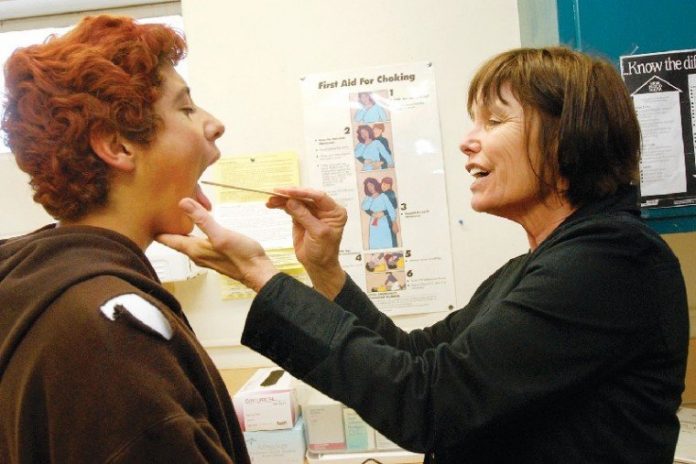On any given weekday, only three to five school nurses are
tending the 10,000 students in Gilroy. The National Association of
School Nurses recommends one nurse to every 750 healthy
students
– in Gilroy that ratio swells to one in every 2,500 students,
said Eileen Obata, the Gilroy district nurse.
Sara Suddes – staff writer
On any given weekday, only three to five school nurses are tending the 10,000 students in Gilroy. The National Association of School Nurses recommends one nurse to every 750 healthy students – in Gilroy that ratio swells to one in every 2,500 students, said Eileen Obata, the Gilroy district nurse.
The shortage of school nurses is affecting students across the country.
Obata has been a school nurse in the Gilroy Unified School District for 29 years and the head district nurse for the past 10.
“I don’t think there’s ever been a year when we felt like there were enough nurses,” Obata said.
The shortage results from two major issues: lack of funding and a dearth qualified school nurses, Obata said. She explained that the first thing to go is funding for school nurses when issues arise with the school budget. Also, school nurses must obtain a bachelor’s degree in nursing with a public health nursing certificate. The additional credential requires more education than a registered nurse.
Because of the shortage, the duties of the certified school nurses are often deferred to the nine health clerks employed by the district. Health clerks receive CPR and first aid training. One health clerk is in the nurse’s office at each school for several hours a day to take care of minor issues such as skinned knees, headaches and runny noses. School nurses each have one on-call day and spend the other four days circulating about their assigned schools performing regular duties of administering vision and hearing tests, distributing medication and attending to any emergency that may arise.
“It’s not that our school district doesn’t care about the shortage of school nurses,” Obata said Wednesday from her post at South Valley Middle School. “Since Deborah Flores started as superintendent, she’s added a 0.6 school nurse position (the equivalent of three days per week) and nine hours per day of a health clerk position.”
Despite Flores’ efforts, the ratio of school nurses to students is still not near the ratio suggested by the NASN.
“I’m concerned that there isn’t more coverage on campus for the hours that the children are on campus,” said Laurie Weber, the parent of a student at Las Animas. “There are hours at a time when there’s no health clerk or nurse scheduled to be at the school.” This situation is occurring across the district.
Often the office staff performs the duties of the nurses and health clerks when they can’t be there.
“People in the school office usually function as a team and the child is at the center,” Trustee Pat Midtgaard said. “I’ve never seen anyone say ‘I’m not taking care of that child because it’s not my job.’ People cover for each other. It may not be right, but that’s how it is in the real world.”
“There just isn’t sufficient funding to hire additional nurses,” said Francisco Dominguez, school board member and father of school-aged children. “I think it’s troubling, as a parent, that the kids might not get the care they need, but families need to be taking preventative measures to keep kids healthy.”
The lack of nurses is even more critical when the students have a pre-existing condition. The amount of diabetics has almost doubled in the past five years and childhood obesity is up, Obata said. Each school has worked out a plan for the students with health conditions from the first day of the school year should an emergency occur. In an extreme emergency, staff calls 911.
Midtgaard agreed that the welfare of the students is primary. An elementary school principal in GUSD for 15 years, she experienced first hand the situation that occurs when a nurse or health clerk is unavailable, but said for the most part, the system serves its purpose.
“You could count on someone to be there very quickly,” Midtgaard said. “The nurses and health clerks in the district do a fantastic job.”
Midtgaard said that the issue is on the school board’s agenda but has not been discussed at length but if the board can find the funds necessary to alleviate the problem, it will.













